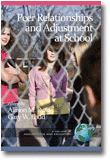
Peer Relationships and Adjustment at School
Edited by:
Allison M. Ryan, University of Michigan, Ann Arbor
Gary W. Ladd, Arizona State University
A volume in the series: Adolescence and Education. Editor(s): Daniela K. DiGiacomo, University of Kentucky. Erica Van Steenis, University of California Irvine.
Published 2012
This volume brings together an impressive array of respected scholars to examine the varied and complex ways in which peers influence adolescents’ beliefs and behaviors in the school context. The breadth of peer influence on academic and social adjustment is evident in the wide variety of topics covered in the present volume. Throughout the chapters, scholars provide unique insights regarding the complex ways that the academic and social spheres of adolescents’ lives are interconnected. Collectively, the chapters in this volume expand current knowledge and theory in peer relations research by (a) exploring different types of peer relations (e.g., close friendships, peer groups) and different peer dynamics (e.g., popularity, bullying) that emerge in the school context, (b) examining different processes that explain why and how peers influence each other in school, (c) considering developmental issues during adolescence that may be critical to understanding peers and adjustment at school and (d) providing information about how teacher practices or programs influence peer relations and school adjustment. Peer Relationships and Adjustment in School is an important volume for researchers and practitioners interested in social development, peer relationships and youth engagement and achievement in school.
CONTENTS
Peer Relationships and Adjustment at School: An Introduction, Allison M. Ryan. PART I: PEER RELATIONSHIPS: NATURE, PROCESS, AND IMPLICATIONS FOR SCHOOL ADJUSTMENT. Classroom Peer Relations and Children’s Social and Scholastic Development: Risk Factors and Resources, Gary W. Ladd, Becky Kochenderfer-Ladd, Kari Jeanne Visconti, and Idean Ettekal. Will the Real Peer Group Please Stand Up? A “Tensegrity” Approach to Examining the Synergistic Influences of Peer Groups and Friendship Networks on Academic Development, Thomas A. Kindermann and Ellen A. Skinner. Peer Relationships and Social Motivational Processes, Kathryn R. Wentzel, Alice Donlan, and Danette Morrison. Children’s Achievement-Related Discourse with Peers: Uncovering the Processes of Peer Influence, Ellen Rydell Altermatt. Popularity and School Adjustment, Antonius H. N. Cillessen and Yvonne H. M. van den Berg. Social Achievement Goals and Adjustment at School During Early Adolescence, Allison M. Ryan, Rhonda S. Jamison, Huiyoung Shin, and Geneene N. Thompson. PART II: PRACTICES AND INTERVENTIONS THAT SUPPORT POSITIVE PEER RELATIONSHIPS AT SCHOOL. Teachers as Managers of Students’ Peer Context, Jan N. Hughes. Peer Cultures of Academic Effort and Achievement in Adolescence: Why They Matter, and What Teachers Can Do About Them, Jill V. Hamm, Abigail Hoffman, and Thomas W. Farmer. The Coping Power Program for At-Risk Aggressive Students, John E. Lochman, Caroline Boxmeyer, Nicole Powell, Joan Barth, and Edward D. Barker. KiVa Anti-Bullying Program: Implications for School Adjustment, Christina Salmivalli, Claire F. Garandeau, and René Veenstra.
-
Paperback978-1-61735-807-4
Web price: $45.04 (Reg. 52.99)
-
Hardcover978-1-61735-808-1
Web price: $80.74 (Reg. 94.99)
- eBook978-1-61735-809-8

- EDU038000 - EDUCATION: Student Life & Student Affairs
- EDU014000 - EDUCATION: COUNSELING: Academic Development
- EDU026050 - EDUCATION: Special Social Disabilities
-
 #youthaction
Becoming Political in the Digital Age
#youthaction
Becoming Political in the Digital Age
-
 Black Girl Civics
Expanding and Navigating the Boundaries of Civic Engagement
Black Girl Civics
Expanding and Navigating the Boundaries of Civic Engagement
-
 Educating Adolescents
Challenges and Strategies
Educating Adolescents
Challenges and Strategies
-
 Power, Equity and (Re)Design
Bridging Learning and Critical Theories in Learning Ecologies for Youth
Power, Equity and (Re)Design
Bridging Learning and Critical Theories in Learning Ecologies for Youth
-
 Self-Efficacy Beliefs of Adolescents
Self-Efficacy Beliefs of Adolescents
-
 The Changing Landscape of Youth Work
Theory and Practice for an Evolving Field
The Changing Landscape of Youth Work
Theory and Practice for an Evolving Field
-
 The Ones We Remember
Scholars Reflect on Teachers Who Made a Difference
The Ones We Remember
Scholars Reflect on Teachers Who Made a Difference

